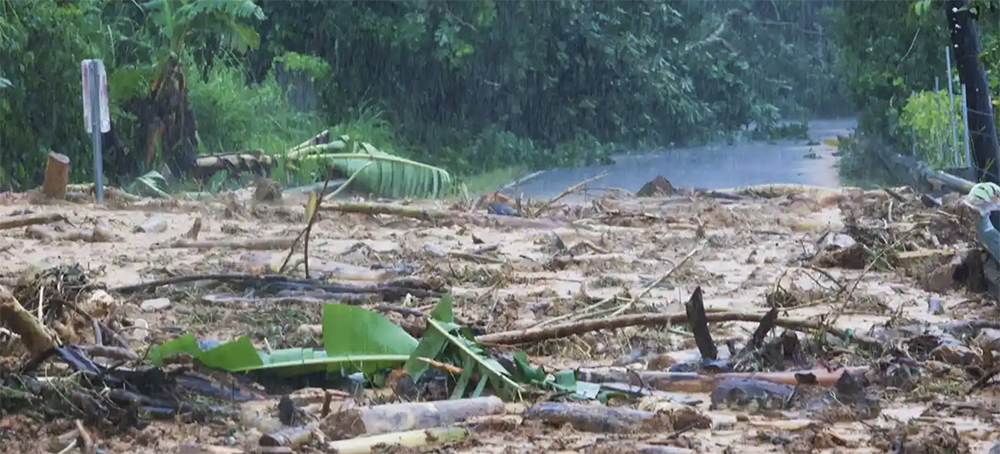Flooding and Landslides in Puerto Rico After Hurricane Fiona Knocks Out Power to Island
Nina Lakhani Guardian UK A mudslide blocks a road in Cayey. (photo: Stephanie Rojas/AP)
A mudslide blocks a road in Cayey. (photo: Stephanie Rojas/AP) Flooding and Landslides in Puerto Rico After Hurricane Fiona Knocks Out Power to Island
Nina Lakhani Guardian UK
Category 1 storm damage ‘catastrophic’, says governor, while it continues to strengthen and barrels toward Dominican Republic
Hurricane Fiona was causing “catastrophic flooding” in Puerto Rico early on Sunday evening, the National Hurricane Center (NHC) said.
Several landslides had been reported, government officials said. The storm forced the closure of roads while a highway bridge in Utuado town in the island’s center had been washed away by a flooding river.
Lights went out across Puerto Rico just after 1pm, leaving only those households and businesses with rooftop solar or functioning generators with power.
Electricity was initially completely out across the island, said Luma Energy, operator of the island’s grid. Some power had begun to be restored on Sunday night, with priority given to hospitals and other critical community services, energy officials said, but reconnecting the whole island would take several days.
“This has been catastrophic,” Puerto Rico’s governor, Pedro Pierluisi, told reporters in San Juan on Sunday night. “We are responding to the emergency as weather conditions permit.”
The health minister confirmed earlier that a major cancer hospital in the capital of San Juan was without power after its backup generator failed. An emergency shelter in Sabana Grande in the south-west, where dozens of locals including some infirm residents had sought refuge, was also without power after its generator failed, according to Ruth Santiago, an environmental lawyer and campaigner for Queremos Sol, a grassroots movement to transition the island away from a centralized energy grid to rooftop solar.
“The only thing that can save us this time is that Fiona is not as strong as Maria because so little has changed – the whole transmission system is down,” Santiago said from Salinas, a town being battered by gusty winds and torrential rains. “The Fema money [federal funds to rebuild the energy system after Maria] should have been spent on rooftop solar … if people die, the Biden government will have blood on its hands.”
Fiona’s center made landfall on Puerto Rico’s south-western coast near Punta Tocon at 3.20pm ET (19.20 GMT) on Sunday with maximum sustained winds of about 85mph (140km/h), the NHC said. The storm was upgraded from a tropical storm to a hurricane on Sunday morning.
Ports are closed and flights out of the main international airport have been canceled. Flash floods, landslides and high winds have already damaged crops in the south of the island, with more dangerous conditions forecast through Monday.
Hurricane #Fiona could produce 12-16" of rain, possibly up to 25", over portions of Puerto Rico. These rains will pose an extreme life-threatening flooding risk, especially over southern and eastern portions of the island.@NWSSanJuan: https://t.co/2iimGXc4sq pic.twitter.com/ohN1oWFg6r
— National Hurricane Center (@NHC_Atlantic) September 18, 2022
Torrential rains and mudslides were also forecast for the Dominican Republic, where the hurricane made landfall in the early hours of Monday morning as it progressed north-westward. The Turks and Caicos Islands likely face tropical storm conditions on Tuesday, the NHC said.
By Sunday night aid agencies in the Dominican Republic began evacuating residents from high-risk areas in the country’s east. President Luis Abinader postponed a trip to New York to participate in the United Nations general assembly.
Puerto Rico is a tropical archipelago and US territory located a thousand miles or so south-east of Miami. The main island is mostly mountains surrounded by narrow coastal plains where the majority of the 3 million habitants reside in towns and cities. It is one of the most vulnerable places on the planet to extreme weather caused by the climate crisis.
It was devastated by Hurricane Maria in 2017, when the delays in federal government help contributed to the high death toll and slow recovery.
The US president, Joe Biden, has already declared a federal disaster for Puerto Rico, mobilizing the delivery of aid to the island.
Parts of Puerto Rico could see up to 25 inches of rain on Monday, which the NHC warned “pose an extreme life-threatening flooding risk”. Storm surges could cause flooding of 1-3 ft above normally dry ground along the eastern and southern coast of the main island and the smaller ones of Vieques and Culebra, according to the NHC, which is part of the national weather service.
Fiona is likely to further damage Puerto Rico’s fragile centralised electricity grid, which Hurricane Maria exposed and exacerbated, and continues to fail residents with frequent power outages and extortionate bills.
It headed to US territory after battering several eastern Caribbean islands, with one death reported in the French territory of Guadeloupe late last week. On Sunday, the French president, Emmanuel Macron, said France would recognise a state of natural disaster for the island.
Meanwhile, almost 5,000 miles away in Alaska, residents were waking up to a trail of destruction caused by a historic storm that impacted almost 1,000 miles of Alaska’s coastline over the course of Friday and Saturday.
The governor, Mike Dunleavy, issued a disaster declaration on Saturday after the powerful storm, the remnant of Typhoon Merbok, forced hundreds of people to evacuate their homes as seawater surged as high as 50ft in some areas, with heavy rainfall and wind gusts up to 90mph. No loss of life has been reported.
On Sunday, Dunleavy said the state needed to move quickly to assess and repair damage to infrastructure like roads and bridges, as freezing Arctic temperatures are likely to hamper efforts within a few weeks.
